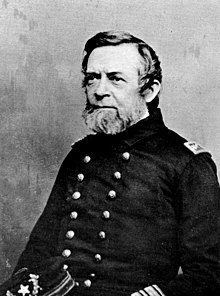Great update, could we have a small reminder of the position of troops and how war-weary all the various states are at this point of the war?
So i'm only going to do the Western Theater for now, as the last few chapters provide the troop dispositions in the East, and the war weariness in Eastern states will be more addressed as we continue onwards:
So the Union armies in the West are currently laid out as such:
Army of Western Tennessee (VIII Corps)
MG Ulysses S. Grant
1st Division MG John McClernand
2nd Division MG Lew Wallace
3rd Division BG Stephen Hurlbut
4th Division BG William Tecumseh Sherman
The Army of Western Tennessee is currently charged with the occupation of the lines of supply stretching back to Paducah. Currently it is marching back from its previous position looking across the Tennessee River and towards Corinth, with the Divisions of McClernand, Lew Wallace and William Tecumseh Sherman leading the charge. Hurlbut's division, after the hard fighting at Grand Junction, is holding Memphis in conjunction with the navy.
Army of the Mississippi (XI Corps)
MG John Pope
1st Division BG David S. Stanley
2nd Division BG Schuyler Hamilton
3rd Division Eleazar A. Paine
Pope's corps, after helping with the victories at Island No. 10 and the fall of Memphis, is marching south towards Grenada. However, even facing the weakened Confederate Army of the Mississippi (god what a problem for correspondents!) he still would have trouble threatening the Confederates at Vicksburg due to the now stronger Confederate Mississippi Squadron and the terrain difficulties. He has some of the supplies from Memphis (Grant could hardly say no) but they would need a significant amount to hope to interdict the Confederate army.
Army of the Ohio (IX Corps)
MG George H. Thomas
1st Division BG Robert Latimer McCook
2nd Division MG Alexander McCook
3rd Division BG Thomas L. Crittenden
4th Division BG Thomas J. Wood
The four divisions of the Army of the Ohio under George Thomas have been principally engaged in defending Louisville and western Kentucky from Confederate encroachment. Wood and Robert McCook's divisions are engaged in garrisoning Louisville and the supply lines while Alexander McCook and Crittenden accompany Thomas south to try and take Frankfort. More on that in Chapter 63...
Army of the Missouri (XVI Corps)
MG Samuel R. Curtis
1st Division BG Jefferson C. Davis
2nd Division BG Alexander Asboth
3rd Division MG* Frederick Steele
Concentrated primarily in northern Arkansas and southern Missouri, the XVI Corps is largely engaged in tit for tat raiding north of Little Rock, while having just provided support to Grant's campaign against Memphis, (*hence Steele's promotion) but currently hopes to drive the Confederate forces to the south of the state to further force the front line towards Vicksburg.
These are the major Union forces operating in the Western theater. There are however, three Confederate armies opposing them:
Army of Tennessee (Gen. Albert S. Johnston)
1st Corps (Maj. Gen. Leonidas Polk)
1st Division: Brig. Gen. Charles Clark
2nd Division: Maj. Gen. Benjamin F. Cheatham
2nd Corps (Maj. Gen. Braxton Bragg)
1st Division: Brig. Gen. Daniel Ruggles
2nd Division: Brig. Gen. Sterling Wood
3rd Corps (Maj. Gen William Hardee)
1st Division: Brig. Gen. Thomas C. Hindman
2nd Division: Brig. Gen. John C. Breckinridge
The Army of Tennessee is the major striking force of the Confederacy in the East, however, it is currently paralyzed by indecision and sitting firmly in entrenchments around Corinth. Commander Johnston has been facing severe criticism in the press, and is getting urgent telegrams from both Richmond and Beauregard's headquarters at Grenada.
Army of the Mississippi (P. T. Beauregard)
2nd Division (Corps): MG Earl Van Dorn
3rd Division (Corps): BG Floyd Tighlman
Though Beauregard has grandiously claimed he commands two corps, each is only a division in size. The 1st division under Sterling Price has been completely destroyed or captured following the fall of Fort Pillow and Memphis, and Van Dorns division is badly out of position holding Nashville and the rivers, and effectively cut off from its home. A new and very green division under Tilghman is all that stands between Pope and Grenada along the Tallahatchee River.
Army of Kentucky (Kirby Smith)
1st Division (MG Thomas Churchill)
2nd Division (BG Patrick Cleburne)
3rd Division (BG Henry Heth)
4th Division (BG Carter L. Stevenson)
The Army of Kentucky holds Eastern Kentucky and the capital at Frankfort and garrisons Eastern Tennessee. Currently four divisions strong it is backed by new Kentucky volunteers and recruits from across the south. Largely spread in garrison, it is now faced by an advance of Thomas's Army of the Ohio.
These are the forces both the Union and Confederacy have going into the spring and summer of 1863.
Currently Missouri and Kentucky have small scale civil wars of their own as Unionists and Confederates battle through the backwoods and raid the lines. East Tennessee is restive, but with the Confederacy far into Kentucky the partisans are largely spying and sabotaging the rail tracks. Of these three states, Kentucky is the most upset. Divided between two effectively military governments (since the flight of Governor Magoffin civilian rule has been absent from Kentucky) and the Confederate Governor Johnson has little real civil authority where Smith's troops aren't standing, the people are subject to mass requisition and the whims of local military commanders. Both sides desperately wish for peace and whoever will give it to them has their ear. So far, none is to be had.
War weariness is running high, very high, in Kentucky.


